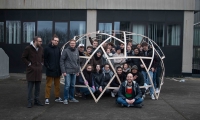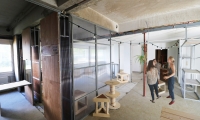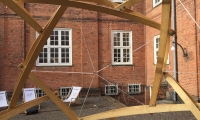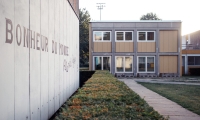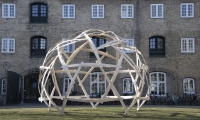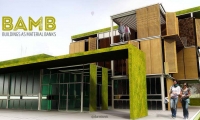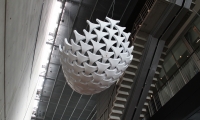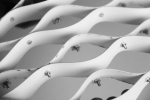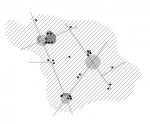Active-bending uses the elastic capacity of flexible components to develop curved structures from initially straight or planar components. As such it is an intuitive and low-tech formation technique. Moreover, the elastic deformation of the components can contribute to the transformational capacity of the resulting structures. Transformable systems can change or reconfigure their shape to accommodate different structural and functional requirements, allow rapid and reversible assembly and thus stimulate reuse of the structure or its components. This transformational capacity makes them well-suited for temporary and kinetic applications. Although many of the recently realised bending-active structures were in fact temporary, not many of them were developed using principles of transformable design. While often simple to produce, most are difficult to assemble. Transformable structures on the other hand facilitate speed of assembly through structural transformations but generally require a certain degree of technical complexity to do so. This dissertation links the concepts of active-bending and transformability by developing new structural concepts for rapidly assembled systems with flexible components. Apart from more theoretical and methodological considerations, the work focuses on the development of three case studies: bending-active reciprocal structures, kinetic curved-line folding structures and compliant bar structures. The proposed systems are modular structures that use elastic component formation on the smaller module scale to form structural configurations that can be easily manufactured, rapidly and reversible assembled, and allow compact storage, transportation and reuse.
Stijn Brancart
Contact
Publications
Links
Stijn Brancart
Dr. ir. arch. Stijn Brancart (°1990) is an expert in sustainable structural design, circular design and the design of lightweight transformable structures. He was based at VUB Architectural Engineering from 2013 to 2021. In 2018 he finished his PhD research on rapidly assembled and reconfigurable bending-active systems under the supervision of Prof. Niels De Temmerman and Prof. Lars De Laet. After that he was involved in multiple projects related to the circular built environment, including the Buildings as Material Banks (BAMB) project and the Circular Retrofit Lab.
Currently, Stijn is assistant professor at the department of Architectural Engineering + Technology of Delft University of Technology, where he conducts research on the reuse of load-bearing components, timber and biobased structures. He continues to collaborate with Prof. Niels De Temmerman and Prof. Lars De Laet on the development of lightweight kit-of-parts systems for temporary structures.
Projects
PhD research
Rapidly assembled systems with flexible components: a dialogue between active-bending and transformability
| Date | 2013 - 2018 |
| Supervisors | Niels De Temmerman, Lars De Laet and Olga Popovic Larsen |
| Funds | Agency for Innovation through Science and Technology in Flanders (IWT) |
Master’s thesis
Planning for change: an adaptable spatial planning approach towards sustainable urban development
| Date | 2012 - 2013 |
| Supervisors | Niels De Temmerman and Marc Martens |
The rapid increase of urbanisation and population worldwide has led to the proliferation of related urban sustainability problems. Consequently, urban areas are in need of theories that can guide them towards more sustainable urban development. Spatial planning approaches should enable cities to respond to changing conditions and survive unexpected shocks and fluctuations. The often static nature of urban elements and spatial organisations results in high construction and demolition waste and the inability to adapt to changes, causing high vacancy rates, shortages and destabilisation of the urban system, amongst other problems. Meanwhile, cities are confronted with a growing sense of temporality and urban experimentation that goes against the prevalent ‘dream of permanence’ and a craving for stability and security.
Planning for change proposes an adaptable spatial planning framework aiming to increase the urban system's capacity to adapt to (unexpected) changes. Its key element is a layer approach that combines spatial elements with a similar rate of change. The approach redefines the role of the planner/designer as the 'director' of existing urban processes in contrast to the obstinate notion of the urban 'creator'. Based on the study of urban transitions and complex adaptive systems, this approach stimulates design and planning to interact with the urban system's complex processes, such as self-organisation and emergence. Thus, these changing procesess can steer a more sustainable urban development.
Awards
Most innovative structural concept at the IASS 2015 International Expo on Future Visions in Structural Engineering
| Date | 2015 |
The Undulatus project was awarded the prize for most innovative structural concept during the International Expo on Future Visions in Structural Engineering in Amsterdam. After a short presentation by Stijn Brancart, the jury of the International Association for Shell and Spatial Structures selected the Undulatus out of 30 pavilions, for its innovative structural design concept, rapid assembly method and parametric design and fabrication.

